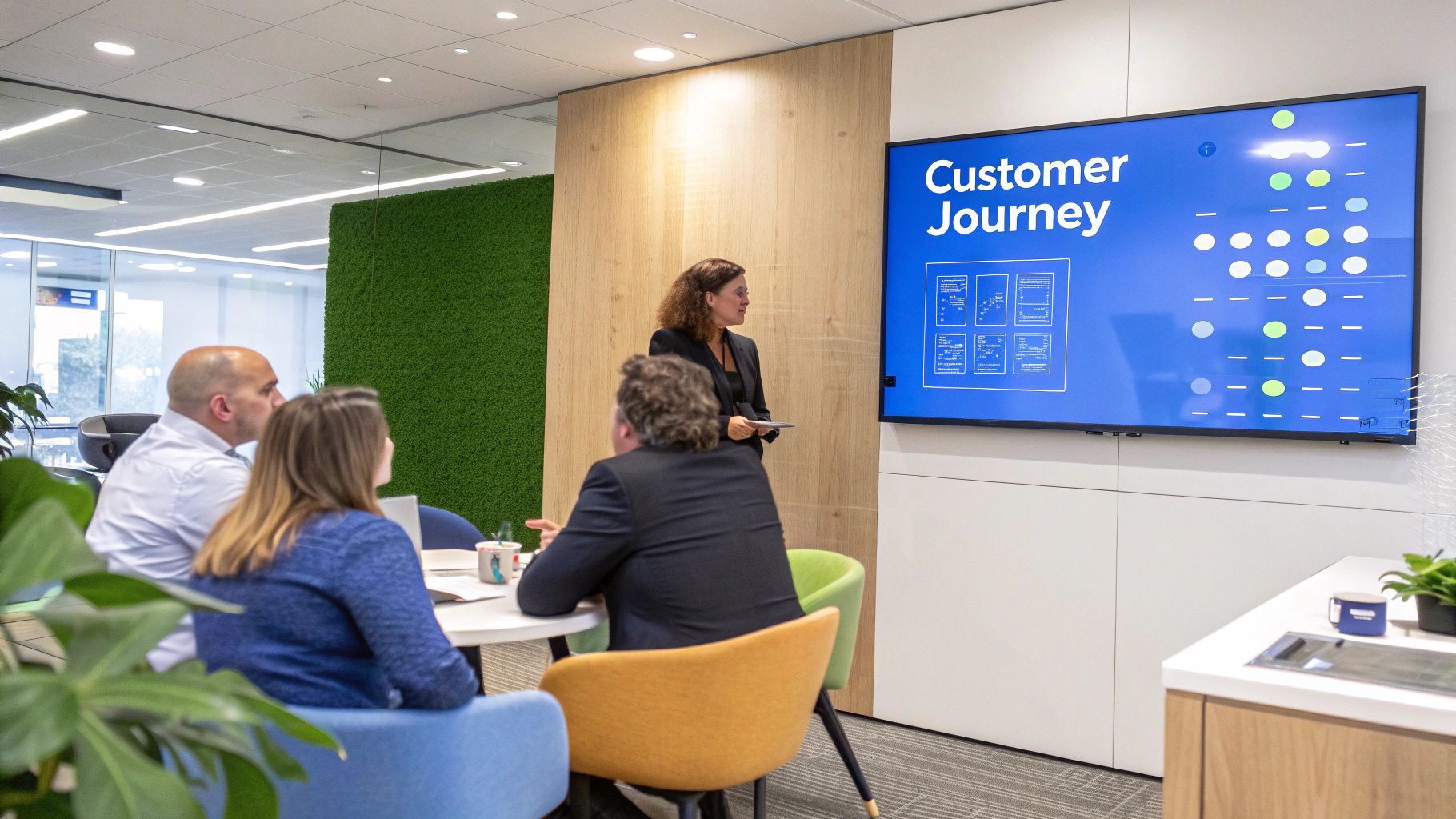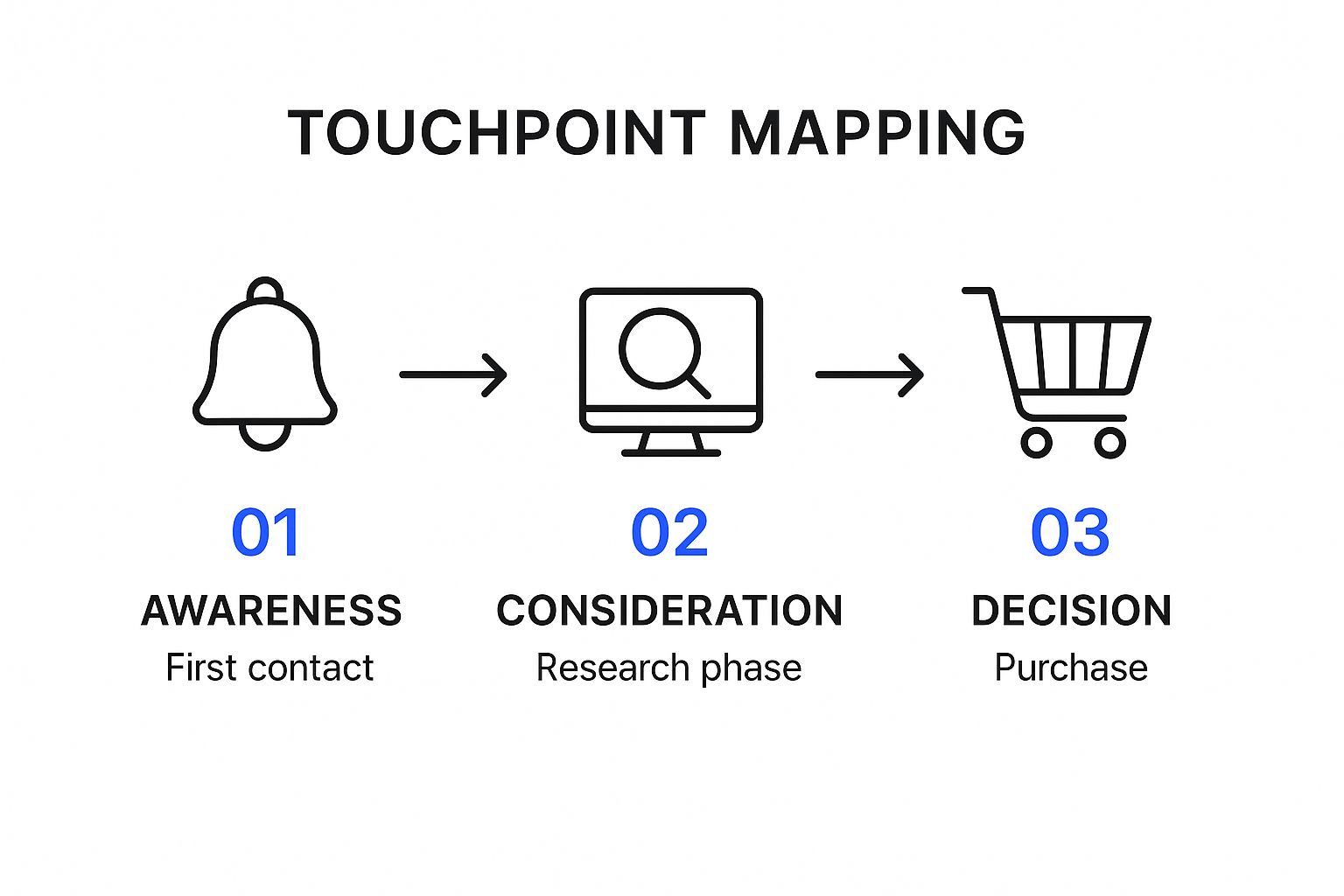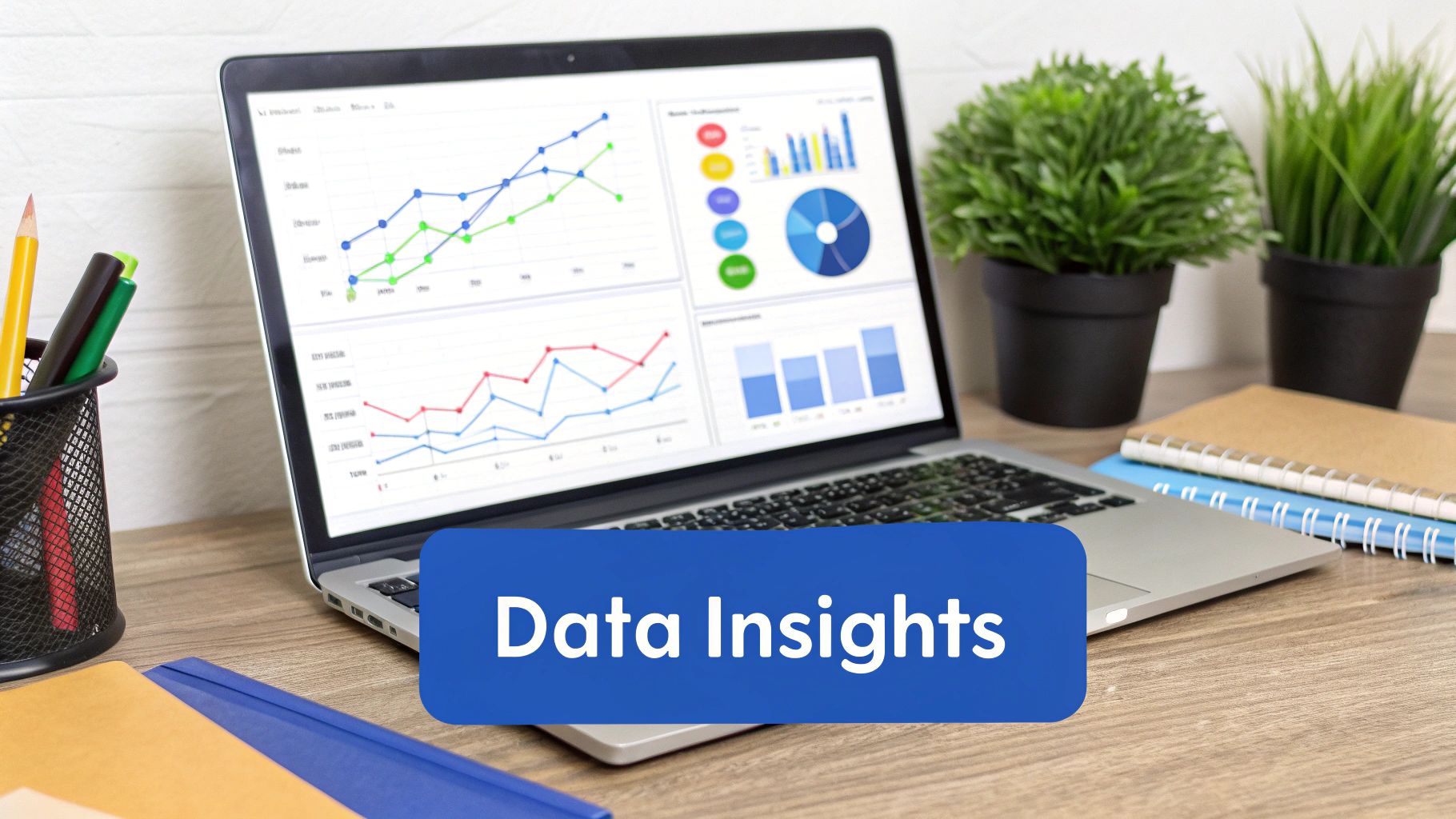
Transform your business with this complete guide to customer journey optimization. Learn to map, analyze, and enhance every touchpoint for real growth.
At its core, customer journey optimization is about looking at every single interaction someone has with your brand and making it better. The goal is to gently guide them toward making a purchase or taking another key action. It's all about creating an experience that feels so smooth and intuitive that it builds loyalty, keeps customers happy, and ultimately, grows your business. This guide will show you exactly how to do that.
Why Customer Journey Optimization Matters Now

Let's be honest, competing on price or features alone is a race to the bottom. Those days are quickly fading. Today, the real battleground is the customer experience. A journey that feels confusing, disjointed, or impersonal is the fastest way to send a potential customer right into the arms of your competition. That's why optimizing the customer journey has shifted from a "nice-to-have" luxury to a fundamental business strategy.
This isn't just a trend; it's a response to sky-high customer expectations. People now expect interactions to be personalized and for the path from discovery to purchase to be completely seamless. It’s a major shift, for sure, but it also presents a huge opportunity for those who get it right.
From Silos to Synergy
Think about how companies used to be structured. Marketing was over here, focused on leads. Sales was in another corner, obsessed with closing deals. And service was on its own island, handling complaints. This siloed approach created a messy and fragmented experience for the one person who mattered most: the customer, who just sees your company as one single thing.
Customer journey optimization is the sledgehammer that breaks down those internal walls. It forces different teams to actually talk to each other and look at the entire experience from the customer's point of view. This ensures every touchpoint feels consistent and connected.
The market is already rewarding this customer-first mindset. The customer journey analytics market is expected to explode, growing at a compound annual rate of 20.8% between 2022 and 2027. This isn't just abstract growth; it's fueled by a powerful reality: 80% of customers now say the experience a company provides is just as critical as its products. You can dive deeper into these customer journey analytics trends to see just how much they're shaping business growth.
A Real-World Retail Transformation
I once worked with a mid-sized online retail brand that was pulling its hair out over high cart abandonment rates. Their products were great, but sales had completely stalled. After we mapped their customer journey, we found the culprit. It was a clunky, multi-page checkout process that forced every single user to create an account. A total conversion killer.
The fix was surprisingly simple. We introduced a guest checkout option and streamlined the entire process onto a single, clean page. The results were immediate. They saw a 15% decrease in abandoned carts and a significant jump in conversions in just one quarter. This is the perfect example of how one small, targeted change, identified through proper journey analysis, can have a massive impact. This guide will give you the framework to find and fix those exact kinds of problems in your own business.
Building Your Customer Journey Map
Before you can fix anything, you have to understand what’s broken. That's what a customer journey map is all about—it's your blueprint for seeing every single interaction someone has with your brand, from their perspective. Forget those overly academic, complex models. A truly useful map is built with real customer data and is designed to pinpoint their goals, emotions, and especially, their pain points. It's about seeing your business through their eyes.
To get started, you need to collect information straight from the source. This isn't about sitting in a conference room and guessing. It’s about blending qualitative and quantitative feedback to paint an authentic picture.
- Surveys and Feedback Forms: Simple tools like Typeform or even basic on-site pop-ups are fantastic for asking direct questions. Ask people how they discovered you, what problem they were hoping to solve, and what—if anything—made them want to tear their hair out during their visit.
- Customer Interviews: Seriously, just talk to your customers. I’ve found that a 15-minute chat with a brand new buyer or a die-hard loyalist can uncover more actionable insights than weeks of internal brainstorming.
- Analytics Deep Dive: Get your hands dirty in your website and product analytics. Where are people bailing? What pages do they look at right before they buy? This data gives you the hard evidence to back up what you're hearing in interviews and surveys.
Identifying Key Journey Stages
Once you have a good pile of data, you can start to give your map some structure by defining key stages. These will differ from business to business, but most journeys follow a classic path through Awareness, Consideration, and Decision. The real magic, however, happens when you flesh out the specific actions, thoughts, and feelings your customers experience within each of those stages.
This visual gives you a simple look at how these core touchpoints flow.

Looking at it this way helps clarify how a customer's needs evolve. You can't talk to someone in the Awareness phase the same way you talk to someone ready to make a Decision. Each phase demands a different approach.
The point isn't just to make a list of touchpoints. It’s to get inside the customer's head at each moment. Are they confused? Excited? Anxious? Figuring this out is what transforms a boring flowchart into a powerful engine for customer journey optimization.
Let's say you're a B2B SaaS company. You might discover that during the Consideration stage, potential buyers feel totally overwhelmed by your long list of features. Their goal is to find a clear solution, but they just feel confused. The pain point is information overload, and the opportunity is clear: create an interactive video demo that lets them explore only the features relevant to their specific job.
Bringing Your Map to Life
A customer journey map is useless if it just sits in a folder on your drive. Think of it as a living document, a blueprint that should guide your team's every move. It's not a one-and-done project.
Let's look at how two very different businesses might map the exact same stage.
| Business Type | Journey Stage | Customer Action | Customer Emotion | Optimization Idea |
|---|---|---|---|---|
| B2C E-commerce | Consideration | Compares three different jackets on the site. | Indecisive | Add a "Compare Products" button and show off photos from real customers wearing the jackets. |
| B2B SaaS | Consideration | Downloads a whitepaper but never books a demo. | Skeptical | Send a short, personalized video email from a sales rep to follow up and answer questions. |
See how much context matters? The e-commerce store tackles indecisiveness with social proof and helpful features. The SaaS company fights skepticism with a personal, human touch. When you map out these nuances, you stop throwing generic fixes at the wall and start making targeted improvements that actually resonate with your audience and drive real results.
Turning Data into Actionable Insights

Having a detailed customer journey map is a fantastic start, but let's be honest—a map is useless if you don't use it to find your way. The real magic happens when you turn that raw data into smart, actionable decisions that genuinely improve the customer experience.
This is where we graduate from just collecting numbers and start asking why they look the way they do.
Effective customer journey optimization is all about connecting the dots. To get the full picture, you need a unified view of your customer. This means looking beyond your website analytics and pulling in data from your CRM, social media channels, and even customer support tickets. When these streams talk to each other, they tell the complete story.
Uncovering the "Why" Behind the Metrics
Every stage of the customer journey has specific metrics that act like warning lights for friction. A high bounce rate on a landing page during the Awareness stage? That's a classic sign of a mismatch between your ad's promise and the page's delivery. Seeing carts abandoned left and right during the Purchase stage? You’ve likely got a snag in your checkout process.
But the numbers themselves are just symptoms. Your real job is to play detective and diagnose the underlying cause. To do that, you need to dig deeper.
- Heatmaps: I'm a big fan of tools like Hotjar for this. They visually show you where users are clicking, scrolling, and hovering. A heatmap might reveal that everyone is trying to click on a non-clickable image, instantly highlighting a confusing design element.
- Cohort Analysis: This is a powerful technique where you group users by a shared characteristic, like their sign-up date. By tracking these groups over time, you can see if a change—like a new onboarding flow—actually improves retention for new users compared to older groups.
By combining these methods, you move from simply identifying problems to truly understanding their root causes. This is the foundation for making changes that actually matter.
To really zero in on friction, it helps to know which metrics to watch at each stage.
Key Metrics for Each Customer Journey Stage
This table breaks down the critical metrics to track at each phase of the customer journey. Monitoring these numbers is your first step in spotting friction points and uncovering opportunities for improvement.
| Journey Stage | Primary Goal | Key Metrics to Track |
|---|---|---|
| Awareness | Attract attention and generate traffic | Bounce Rate, Landing Page Views, Time on Page, Click-Through Rate (CTR) |
| Consideration | Engage and educate potential customers | Content Downloads, Video View Duration, Product Page Views, Return Visits |
| Purchase | Convert prospects into paying customers | Cart Abandonment Rate, Conversion Rate, Average Order Value (AOV) |
| Loyalty | Retain customers and foster advocacy | Repeat Purchase Rate, Customer Lifetime Value (CLV), Net Promoter Score (NPS) |
Watching these metrics consistently will give you a clear, ongoing pulse on your customer experience, making it easier to pinpoint exactly where you need to focus your optimization efforts.
From Insights to Impact
Once you've identified the sticking points and understand why they're happening, you can start making targeted improvements. The most powerful insights often come from spotting patterns across multiple touchpoints.
A core principle of successful customer journey optimization is that small, data-informed changes often produce the biggest results. It’s not about overhauling your entire website; it's about finding and fixing the specific moments where customers get stuck or frustrated.
This isn't just theory; it has tangible benefits. Research shows companies that excel at journey analytics can boost customer satisfaction by 10-15% and cut operational costs by 10-20%. Expedia, for instance, used journey data to pinpoint bottlenecks in its booking flow. By simply streamlining the process, they saw a 10% increase in bookings and a 15% drop in customer complaints.
Connecting your analytics to your other tools is also crucial for acting on these insights quickly. For example, if you identify a common drop-off point in a video, you can trigger an automated, personalized follow-up. Our guide on integrating with marketing automation tools explores how this creates a more dynamic and responsive customer experience.
This proactive approach transforms your data from a static report into a real-time engine for growth.
Using AI for Smarter Journey Optimization
https://www.youtube.com/embed/mhcoffE7-PY
If data gives you the map of your customer's journey, then artificial intelligence (AI) is the smart vehicle that navigates it for you. Modern customer journey optimization isn't just about reacting to problems anymore; it's about getting ahead of them. AI makes it possible to engage customers with proactive, personal touches at a scale we could only dream of a few years ago.
This isn't about sci-fi robots. We're talking about practical, behind-the-scenes tools that smooth out the rough patches in the customer experience. A great example is an AI-powered chatbot. It can offer instant, 24/7 support for common questions, which frees up your human team to tackle the more complex, high-touch issues. This simple change can dramatically reduce friction when a customer is considering a purchase or needs help.
Driving Personalization and Efficiency
The real magic of AI here is its ability to learn and adapt on the fly. It can use predictive analytics to anticipate what a customer might do next. For an e-commerce site, this could mean analyzing browsing behavior to predict the next likely purchase and then featuring those products on the homepage or in a follow-up email. It feels personal because it is personal.
This is where generative AI, or GenAI, has become a game-changer. It can craft personalized email copy, unique product descriptions, or even video scripts designed for specific customer segments, making sure your message hits home every time. Picture an online service that uses AI to scan incoming support tickets. The system doesn't just route the ticket; it also suggests a response based on that specific customer's history, cutting down resolution time and making for a much happier user.
AI transforms customer journey optimization from a manual, segment-based chore into a dynamic, one-to-one conversation. It allows you to deliver a bespoke experience for every single user, automatically.
And this isn't just a niche trend. AI adoption in organizations skyrocketed to 72% in 2024, a massive leap from the steady 50% we saw for the previous six years. On top of that, 65% of companies are now using GenAI on a regular basis. When customer experience leaders were asked where they expect the biggest impact, they pointed to operational efficiency (30%) and cost reduction (28%).
Responsible Implementation and Future Trends
Of course, using AI isn't a free-for-all. It comes with a responsibility to be transparent and ethical. Customers should know when they’re talking to a bot, and their data must always be handled with care. The goal is to use AI to make the human experience better, not to replace it completely.
The best strategies I've seen blend AI's speed and efficiency with a genuine human touch for the moments that matter most.
As AI continues to mature, its role in customer journey optimization will only get bigger. Looking forward, exploring the applications of Agentic AI points to a future where entire journeys could be optimized proactively and autonomously. By integrating AI thoughtfully, you can build smarter, more responsive, and ultimately more profitable customer journeys.
Proven Strategies for Each Journey Stage

Alright, you’ve got your map and the data insights. Now for the fun part: putting it all into action. I’ve found that true customer journey optimization isn’t about some massive, one-and-done project. It’s actually about making a series of smart, targeted tweaks at each point along the customer’s path.
This means you need to get inside your customer's head and figure out what they need at that specific moment. Let’s walk through the practical strategies I’ve seen work time and again for smoothing out the bumps and creating real value across the entire journey.
Capturing Attention in the Awareness Stage
When someone is in the Awareness stage, they’ve got a problem, but they might not even know your brand exists. Your entire goal here is to show up and be genuinely helpful.
This is where you need to invest in solid SEO so you’re the one they find when they start searching for answers. Think about creating valuable blog posts, in-depth guides, or short, informative videos that address their initial pain points. Don't go for the hard sell. For example, an accounting software company could create an article on the "Top 10 Tax Mistakes Small Businesses Make." This positions them as a credible expert long before the customer is even thinking about buying software.
Guiding Prospects Through Consideration
Once a prospect knows who you are, they move into the Consideration stage. Now, they're actively weighing their options. Your job is to make it crystal clear why you’re the best solution for them. This is where details and clarity really matter.
- Offer Detailed Comparisons: Don't be afraid to create an honest comparison page showing how your product stacks up against the competition.
- Provide Interactive Demos: Instead of a one-way video, use an interactive tool like VideoQi to let prospects click around and explore the features they actually care about. I've seen B2B SaaS companies have great success letting users click through a simulated workflow—it’s infinitely more engaging.
- Showcase Social Proof: Make sure your customer testimonials, case studies, and user reviews are front and center. Nothing builds trust like seeing that other people have already found success with your solution.
A critical mistake I see people make here is just dumping information on prospects. Instead, give them the tools to find their own answers. An interactive video demo, for instance, lets them qualify themselves, which always feels more authentic than a sales pitch.
Streamlining the Purchase Experience
The Purchase stage is where so many companies drop the ball. Even a tiny bit of friction at this point can send a potential customer running for the hills. The goals here are absolute simplicity and trust.
Make your checkout process as smooth as humanly possible. Offer a guest checkout so people don't have to create an account if they don't want to. Be completely transparent with all costs upfront—nobody likes surprise shipping fees on the final step. It's also a great idea to offer multiple payment options, like credit cards, PayPal, and even "buy now, pay later" services, which can seriously improve website conversions.
Fostering Loyalty Through Retention
The relationship doesn't end once the payment goes through. In many ways, it's just beginning. The Retention stage is all about delivering on your promises and providing so much value that a one-time buyer becomes a lifelong fan.
Personalized onboarding is absolutely key. Set up a welcome email series or create short tutorial videos that help new customers get their first "win" with your product as quickly as possible. Proactive support is another game-changer. Use your data to spot users who seem to be struggling and reach out with help before they even think to ask for it.
Creating Brand Advocates
This is the holy grail of customer journey optimization: Advocacy. This is where your happy, loyal customers start doing your marketing for you. To get here, you need to make it incredibly easy for them to share their positive experience.
Implement a simple referral program that rewards both the person sharing and their friend. A few weeks after a purchase, send a friendly email asking for a review and include direct links to make it a one-click process. If you want to get really sophisticated in how you connect all these touchpoints, look into effective customer journey orchestration techniques. This is how you ensure every stage flows seamlessly into the next, building momentum that turns customers into your biggest fans.
Frequently Asked Questions
As you start digging into customer journey optimization, some common questions always seem to pop up. Let's tackle a few of the ones I hear most often so you can move forward with confidence.
How Often Should I Update My Customer Journey Map?
Your journey map isn't a "set it and forget it" project; it’s a living document. I always advise a formal review and update at least quarterly, or bi-annually at the very least. This rhythm ensures it stays aligned with how your business is actually operating.
That said, don't wait for your scheduled review if something big happens. You need to pull out the map and make adjustments immediately whenever you:
- Launch a major new product or feature.
- Expand into a new market or start targeting a different demographic.
- Get a flood of customer feedback that signals a change in their needs or behaviors.
- See a sudden, significant drop or spike in your key metrics.
Agility is key. Your optimization efforts have to be based on what's happening right now, not what was happening six months ago.
What Is the Biggest Mistake to Avoid?
Without a doubt, the single biggest mistake is creating a perfect, detailed journey map… and then letting it collect digital dust. Its power is in its application. If that map isn't directly influencing your marketing campaigns, your product roadmap, or your customer service training, it's just a pretty picture.
A close second is mapping the journey you think or want your customers to take, based only on internal meetings. That's a classic misstep. Your map must be built on a foundation of real-world data—analytics, surveys, and most importantly, direct customer conversations. The goal is to see the journey through their eyes, not your ideal version of it.
The best journey optimization strategies come from authentic customer data, not boardroom brainstorming. Think of the map as a tool for action, one that points you directly to the friction you need to fix.
Can Small Businesses Really Do This?
Absolutely. Customer journey optimization is a mindset and a process, not a budget line item reserved for giant corporations. You might not have access to a six-figure analytics suite, but you can get incredibly powerful insights from tools that are free or very affordable.
Google Analytics is a goldmine of user behavior data. Free tools like Typeform or SurveyMonkey are perfect for gathering direct feedback. And honestly, nothing beats just talking to your customers. Understanding and smoothing out touchpoints is a fundamental principle that helps a local coffee shop just as much as it helps a multinational tech company. A great first step is getting a handle on your metrics, and you can learn more about the right content performance metrics to track.
Ready to turn passive video viewers into active, engaged customers? VideoQi helps you build interactive video experiences that guide people through their journey, from the first click to the final conversion. See how you can boost engagement and drive real results. Start your journey with VideoQi today!


